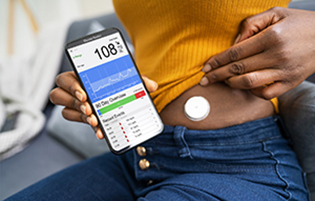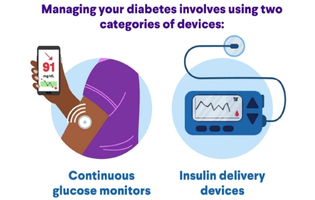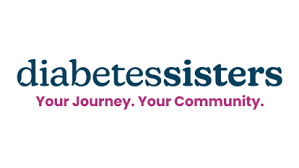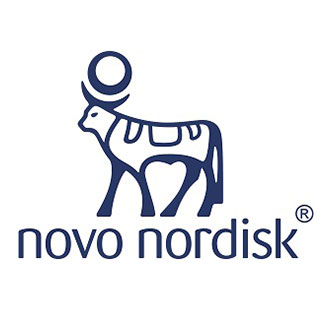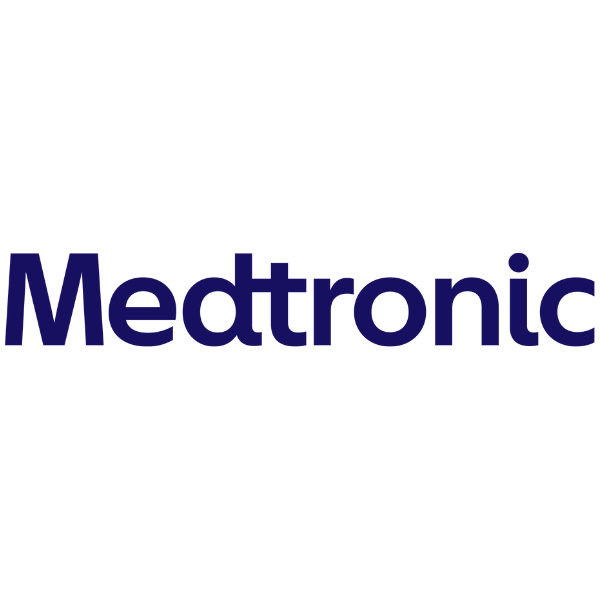Home
Contemplation

Contemplation
Thinking About Diabetes Technology
Maybe you recently received a diabetes diagnosis and know very little about diabetes technology. Or perhaps you have had diabetes for a while and would like to learn about the types of technology available to people with diabetes. You may even use some diabetes technology already but want to find out what other choices you have.
Wherever you are on your diabetes journey, learning about diabetes self-care and diabetes technology can empower you to take the best possible care of yourself. Here, we provide some basic information that will help you learn about diabetes technology.
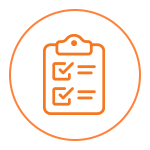 Key Facts About Diabetes Management Technology
Key Facts About Diabetes Management Technology
To begin with, let's talk about what we mean by the phrase "diabetes technology." Diabetes technology refers to any tool, device, or technology that can help you monitor your blood sugar (glucose) levels, recognize blood sugar trends, or guide you in your lifestyle choices. In addition, diabetes devices can guide you in making informed decisions about your medication doses, particularly if you use insulin therapy to manage your diabetes.
Examples of diabetes technology include:
- Continuous glucose monitors (CGMs): Measure the glucose in your interstitial fluid. Most personal CGM devices check your interstitial glucose every one to five minutes and allow you to see your glucose trends in real time and continuously. (Note: Although they may be referred to as blood sugar monitors, CGMs actually measure the glucose in your interstitial fluid, rather than your blood.)
- Blood glucose meters: Provide a snapshot of your blood sugar values at a given moment.
- Insulin pens: Injection devices that come prefilled with insulin.
- Smart insulin pens: Prefilled insulin pens that can connect to a smartphone app.
- Smart (connected) pen caps: CGM devices that connect to a smart insulin pen. They record and send information about insulin timing and dosing to a smartphone app.
- Traditional insulin pumps: Devices worn on your body that deliver insulin into the fatty tissue just below the surface of your skin, where it is absorbed into your bloodstream. Advanced insulin pumps can also calculate and track insulin doses.
- Patch pumps: Devices that attach directly to your skin to deliver insulin. Some can calculate or track insulin doses.
- Automated insulin delivery systems: Devices that combine a CGM, an insulin pump, and a device that delivers insulin automatically. These systems calculate and track insulin delivery and can adjust insulin doses to help you meet your blood sugar targets.
- Inhaled insulin: Powdered insulin that you can inhale for bolus (mealtime) doses.
- Smartphone apps: Applications that can support various aspects of your diabetes self-care, including lifestyle changes, meal planning, and medication adjustments.
- High-speed internet service and/or Wi-Fi are required for some of these technologies.
Note: See Planning & Treatment for detailed information about these and other types of diabetes technology.
Benefits of Diabetes Technology
Diabetes technology can help you manage your diabetes in a few ways. To begin with, it can make it easier for you to manage your blood sugar so it doesn’t go too low (hypoglycemia) or too high (hyperglycemia). This is important because keeping your blood sugar in your target range helps prevent or delay other conditions (complications) that can be caused by diabetes.
Diabetes technology can also simplify the way you and your health care professional review your blood sugar levels over time and use that information to set goals, identify areas that need improvement, and work together to discuss treatment plans.
In addition, diabetes technology can make it less burdensome to take insulin by making it easier to self-administer insulin and take the right amount when you need it. It can also allow you to take insulin throughout the day and night without having to give yourself multiple injections.
Finally, some types of diabetes technology — such as smartphone apps — can help you meet your lifestyle goals by helping you track what you eat, how much you move, and how much you sleep. Making healthy choices about food, fitness, weight management, and other lifestyle goals can help you keep your blood sugar in your target range and lower your risk of developing diabetes complications.
Your health care professional can tell you more about whether diabetes technology may be right for you. However, in general, it may be recommended if you:
- Are taking insulin
- Are at high risk for episodes of hypoglycemia (low blood sugar)
- Have trouble tracking your blood sugar levels with finger prick testing
- Have trouble keeping your blood sugar in range using minimal diabetes technology support
- Are pregnant and need insulin for diabetes
- Have gestational (pregnancy-related) diabetes
- Are a child or teen with insulin-dependent diabetes
Note: For more information about which types of diabetes technology might be right for you, see Planning & Treatment.
Did You Know?
Diabetes Technology
- The Ames Research Division of Miles Laboratories developed the first blood glucose test strip, which was known as Dextrostix, in 1965.
- The first insulin pump was developed in the late 1970s.
- The first insulin pen was developed in 1985.
- The first CGM system was approved by the U.S. Food and Drug Administration (FDA) in 1999.
- The first hybrid closed-loop insulin delivery system was developed in 2015.
- The U.S. FDA approved the first cellular therapy to treat people with type 1 diabetes in 2023. The treatment transplants insulin-producing pancreatic cells from deceased donors into the bodies of people with type 1 diabetes who are unable to keep their blood sugar in range despite careful medical management. Some participants in clinical trials were able to stop taking insulin for one to five years or more after receiving cellular therapy.
 Current Health Status
Current Health Status
What to Consider When Thinking About Diabetes Technology
Whether you are newly diagnosed or have lived with diabetes for a while, here are some questions to keep in mind as you learn about diabetes technology:
What is your experience managing your diabetes?
Are you new to diabetes management, or have you been doing it for a long time? Are you comfortable with finger-prick blood tests, or would you rather do less of that? Do you take insulin? How convenient is it to give yourself insulin shots? If you are frustrated with your current diabetes management plan — or if you are new to diabetes management and concerned about daily finger pricks and/or having to give yourself frequent insulin injections — diabetes technology could make diabetes management more convenient.
How are you doing with reaching your blood sugar goals?
It's important to keep your blood sugar in your target range. (Your health care professional will talk with you about your target blood sugar range.) Depending on your situation and preferences, diabetes technology may help you hit your blood sugar targets and lower your risk of developing diabetes complications.
What other health conditions do you have?
Having certain health conditions makes it even more important that you manage your diabetes carefully. For example, if you have conditions that affect the health of your eyes, heart, nerves, or kidneys, it's important to manage your diabetes so those conditions don't get worse. Using diabetes technology to keep your blood sugar in the target range could help prevent future health problems.
Did You Know?
Diabetes and Smoking
- Smoking is dangerous for everyone but especially for people with diabetes. Not only is type 2 diabetes 30-40% more likely to occur in people who smoke, but smoking can make it harder for people with diabetes to manage their condition.
- If you have diabetes and smoke, you have a higher risk of developing diabetes-related complications such as problems with your heart, kidneys, nerves, and eyes. What's more, reduced blood flow due to smoking can raise your risk of limb amputation.
- Talk with your health care professional if you need help quitting or visit smokefree.gov.
Diabetes and Heart Health
- People with diabetes have double the risk of heart disease or stroke than people who don't have diabetes. However, you can help lower that risk by quitting smoking, being active, eating a heart-healthy diet, losing excess weight, and keeping your blood sugar in range.
- High blood pressure is common in people with diabetes. Cholesterol may be higher than desired. Be sure you see your health care professional regularly for blood pressure and cholesterol checks, and treatment if appropriate.
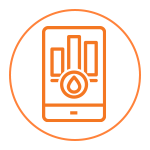 Technology Already Utilized
Technology Already Utilized
If you are already using diabetes technology and want to upgrade your device or your insurance coverage has changed, it's important to talk with your health care professional about which options are best for you. Consider what you like or dislike about your current device, explore alternative technology options that could be a good fit for your lifestyle, and evaluate how a new device could enhance your blood sugar management.
Are you looking to upgrade your current diabetes technology?
Perhaps you use an insulin pen and would like to consider an insulin pump or inhaled insulin. Or maybe you monitor your blood sugar with daily finger pricks and like the idea of switching to a continuous glucose monitor. Understanding the pros and cons of a new technology can help you decide whether to make the switch.
What is your comfort level with technology?
Learning to use a new technology takes time. However, most devices are designed to be user-friendly, and many people find they quickly grow comfortable with new technology. Your diabetes care team is there to teach you and assist you as you begin your journey with diabetes technology. It's important to maintain open lines of communication with your diabetes care team, so that they can continue to assist you in your learning and progress.
What does your health insurance cover?
Contact your health insurance company and ask your health care professional for details about your coverage.
Talking With Your Health Care Professional
As you move forward and explore your diabetes technology options, here are some tips for talking about it with your health care professional:
- Think about what information you would like to receive from your health care professional.
- Write down a list of questions before your diabetes care appointments.
- Consider bringing a caregiver, such as a family member or friend, with you to your appointments. Having another set of eyes and ears helps to absorb the large amounts of information that are often discussed during a diabetes visit.
- Continue to ask your diabetes care team questions until you feel that you have completely understood the recommendations.
- Talk with your health care professional about your personalized diabetes treatment goals, including target blood sugar ranges and target hemoglobin A1C, which is a blood test that measures your average blood sugar during the previous three months. (To learn more about diabetes basics, refer to this helpful guide.)
- Always communicate with your diabetes care team if you are having difficulty using or understanding your diabetes technology device.
- Ask what kind of training is available for the technology you are considering.
- Ask where you can learn more about the technology you are considering.
- Be sure you know whom to contact if you have questions between appointments. View a list of support groups you can connect with.
For a full list of questions you can take to your appointment, click here.
Did You Know?
Diabetes and Vaccines
- Infections can make it more difficult to manage diabetes. For example, having the flu can raise your blood sugar to dangerously high levels. Protect yourself by having your yearly flu shot and making sure all your other vaccines are up to date.
- Having diabetes can make it harder to fight infections. For example, people with diabetes are at an increased risk of dying from pneumonia. Help protect yourself by asking your health care professional if you need a pneumonia vaccine, and making sure all your other vaccines are up to date.
- Compared to people without diabetes, people with diabetes have worse outcomes from COVID-19 and are three times more likely to be hospitalized for COVID-19 complications. Protect yourself by having COVID-19 vaccines and boosters when recommended.










 DOWNLOAD
DOWNLOAD
